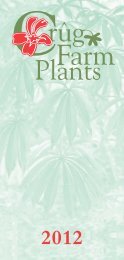downloadable catalogue - Crug Farm Plants
downloadable catalogue - Crug Farm Plants
downloadable catalogue - Crug Farm Plants
You also want an ePaper? Increase the reach of your titles
YUMPU automatically turns print PDFs into web optimized ePapers that Google loves.
South Korea, with larger foliage and inflorescences. While H.<br />
anomala ssp. petiolaris v. ovalifolia BSWJ8799 is the variety from<br />
Cheju-Dõ, South Korea. Please see our description at the end<br />
section of this plant list for more detail of H. chinensis 'Golden<br />
Crane' DJHC0499. Our stocks originating from cuttings I<br />
pinched from Dan Hinkley’s garden when he was away. At least it<br />
goaded him into doing something with it.The following three H.<br />
heteromalla are re-entries, available as open ground plants only,<br />
namely 'Morrey's Form', f. xanthoneura ‘Wilsonii’ & 'Yalung<br />
Ridge'. Also from cultivation this time from Japan are two cultivars<br />
of H. involucrata. ‘Plenissima’ bears corymbs of pale purple-pink<br />
centred sterile double flowers. While H. ‘Yoraku’ has pale pink<br />
fertile flowers surrounded by double creamy coloured sterile florets<br />
in a looser corymb. H. serrata 'Crûg Sõ Cool' BSWJ6241b is<br />
another one of our seedlings from Mt. Unzen area of Kyushu, Japan<br />
in 1998. This small cultivar forming flat topped cymes of blue<br />
flowers in acidic soils. Named formally at the end section of this<br />
plant list. I am sadly unable to trace the origins of the clone of H.<br />
stylosa that we are introducing this year. We were given it many<br />
years ago as one of Beer & Lancaster's collections, but Roy has no<br />
record of such a find. All the same it is high time that this<br />
Himalayan equivalent of H. macrophylla was introduced, it certainly<br />
has the flowering power to make it popular. Flowering power<br />
certainly describes Indigofera howellii regarded by those that study<br />
these things, to be the most floriferous species, bearing pink spikes<br />
of pea flowers from April to October. Many thanks to Louisa<br />
Arbuthnott for making my acquaintance. Jamesia americana is a<br />
rarity in cultivation.We grow a plant of it near our house where it<br />
flowers quietly every year, with cymes of white Deutzia-like<br />
flowers. It is reputedly difficult to propagate, ours are the result of<br />
seed sowing.The fruit of Kadsura heteroclita FMWJ13385 have to<br />
be seen to be believed. Forming twinning woody-stemmed<br />
climbers with thick dark green glossy foliage and white to yellow<br />
flowers. The female flowers transforming to an aggregate of<br />
symmetrical elongated reddish berries, forming a globe like<br />
structure that is certainly larger than a cricket ball. All quite<br />
palatable too. Lindera angustifolia FMWJ13156 was a fortunate<br />
find, growing in a small colony of small trees. The foliage was<br />
lanceolate, thin textured only 10 ? 1.5cm, while the small black fruit<br />
were carried in axillary orbicular clusters. L. metcalfiana v.<br />
dictyophylla KWJ12312 was an earlier find, again with narrow<br />
foliage and small black glossy fruit all along the branches where the<br />
fragrant yellow flowers had made their display March- May. L.<br />
tonkinensis FMWJ13123 is far easier to distinguish, normally<br />
forming small to medium evergreen trees.With parchment textured<br />
ovate leaves distinctly 3-veined, these covered in gingery hair<br />
below.Winter flowering in the wild, but normally early spring for<br />
us, when the branches can be smothered in clusters of the small<br />
yellow flowers. In the same family Litsea cubeba FMWJ13011 is a<br />
56



